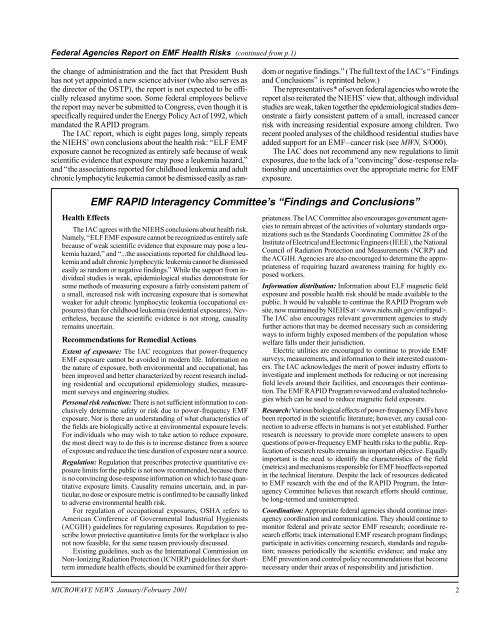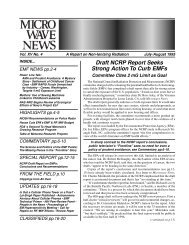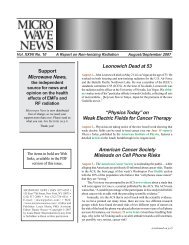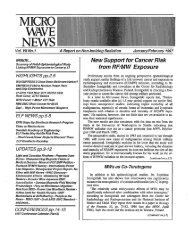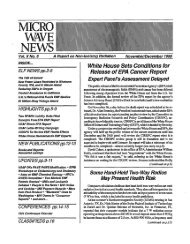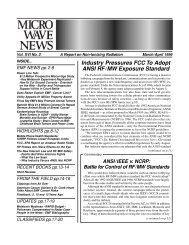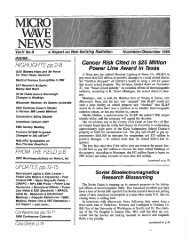Mobile Phones, Cancer Not Linked In Two Short ... - Microwave News
Mobile Phones, Cancer Not Linked In Two Short ... - Microwave News
Mobile Phones, Cancer Not Linked In Two Short ... - Microwave News
Create successful ePaper yourself
Turn your PDF publications into a flip-book with our unique Google optimized e-Paper software.
Federal Agencies Report on EMF Health Risks (continued from p.1)<br />
the change of administration and the fact that President Bush<br />
has not yet appointed a new science advisor (who also serves as<br />
the director of the OSTP), the report is not expected to be officially<br />
released anytime soon. Some federal employees believe<br />
the report may never be submitted to Congress, even though it is<br />
specifically required under the Energy Policy Act of 1992, which<br />
mandated the RAPID program.<br />
The IAC report, which is eight pages long, simply repeats<br />
the NIEHS’ own conclusions about the health risk: “ELF EMF<br />
exposure cannot be recognized as entirely safe because of weak<br />
scientific evidence that exposure may pose a leukemia hazard,”<br />
and “the associations reported for childhood leukemia and adult<br />
chronic lymphocytic leukemia cannot be dismissed easily as ran<br />
dom or negative findings.” (The full text of the IAC’s “Findings<br />
and Conclusions” is reprinted below.)<br />
The representatives* of seven federal agencies who wrote the<br />
report also reiterated the NIEHS’ view that, although individual<br />
studies are weak, taken together the epidemiological studies demonstrate<br />
a fairly consistent pattern of a small, increased cancer<br />
risk with increasing residential exposure among children. <strong>Two</strong><br />
recent pooled analyses of the childhood residential studies have<br />
added support for an EMF–cancer risk (see MWN, S/O00).<br />
The IAC does not recommend any new regulations to limit<br />
exposures, due to the lack of a “convincing” dose-response relationship<br />
and uncertainties over the appropriate metric for EMF<br />
exposure.<br />
EMF RAPID <strong>In</strong>teragency Committee’s “Findings and Conclusions”<br />
Health Effects priateness. The IAC Committee also encourages government agen<br />
The IAC agrees with the NIEHS conclusions about health risk.<br />
Namely, “ELF EMF exposure cannot be recognized as entirely safe<br />
because of weak scientific evidence that exposure may pose a leukemia<br />
hazard,” and “...the associations reported for childhood leukemia<br />
and adult chronic lymphocytic leukemia cannot be dismissed<br />
easily as random or negative findings.” While the support from in-<br />
dividual studies is weak, epidemiological studies demonstrate for<br />
cies to remain abreast of the activities of voluntary standards organizations<br />
such as the Standards Coordinating Committee 28 of the<br />
<strong>In</strong>stituteof Electrical and Electronic Engineers (IEEE), the National<br />
Council of Radiation Protection and Measurements (NCRP) and<br />
the ACGIH. Agencies are also encouraged to determine the appro<br />
priateness of requiring hazard awareness training for highly exposed<br />
workers.<br />
some methods of measuring exposure a fairly consistent pattern of <strong>In</strong>formation distribution: <strong>In</strong>formation about ELF magnetic field<br />
a small, increased risk with increasing exposure that is somewhat exposure and possible health risk should be made available to the<br />
weaker for adult chronic lymphocytic leukemia (occupational ex- public. It would be valuable to continue the RAPID Program web<br />
posures) than for childhood leukemia (residential exposures). Nev- site, now maintained by NIEHS at .<br />
ertheless, because the scientific evidence is not strong, causality The IAC also encourages relevant government agencies to study<br />
remains uncertain. further actions that may be deemed necessary such as considering<br />
Recommendations for Remedial Actions<br />
ways to inform highly exposed members of the population whose<br />
welfare falls under their jurisdiction.<br />
Extent of exposure: The IAC recognizes that power-frequency Electric utilities are encouraged to continue to provide EMF<br />
EMF exposure cannot be avoided in modern life. <strong>In</strong>formation on surveys, measurements, and information to their interested customthe<br />
nature of exposure, both environmental and occupational, has ers. The IAC acknowledges the merit of power industry efforts to<br />
been improved and better characterized by recent research includ- investigate and implement methods for reducing or not increasing<br />
ing residential and occupational epidemiology studies, measure- field levels around their facilities, and encourages their continuament<br />
surveys and engineering studies.<br />
tion. The EMF RAPID Program reviewed and evaluated technolo-<br />
Personal risk reduction: There is not sufficient information to congies<br />
which can be used to reduce magnetic field exposure.<br />
clusively determine safety or risk due to power-frequency EMF Research:Various biological effects of power-frequency EMFs have<br />
exposure. Nor is there an understanding of what characteristics of been reported in the scientific literature; however, any causal conthe<br />
fields are biologically active at environmental exposure levels. nection to adverse effects in humans is not yet established. Further<br />
For individuals who may wish to take action to reduce exposure, research is necessary to provide more complete answers to open<br />
the most direct way to do this is to increase distance from a source questions of power-frequency EMF health risks to the public. Repof<br />
exposure and reduce the time duration of exposure near a source. lication of research results remains an important objective. Equally<br />
Regulation: Regulation that prescribes protective quantitative ex-<br />
posure limits for the public is not now recommended, because there<br />
is no convincing dose-response information on which to base quantitative<br />
exposure limits. Causality remains uncertain, and, in par-<br />
ticular, no dose or exposure metric is confirmed to be causally linked<br />
to adverse environmental health risk.<br />
important is the need to identify the characteristics of the field<br />
(metrics) and mechanisms responsible for EMF bioeffects reported<br />
in the technical literature. Despite the lack of resources dedicated<br />
to EMF research with the end of the RAPID Program, the <strong>In</strong>teragency<br />
Committee believes that research efforts should continue,<br />
be long-termed and uninterrupted.<br />
For regulation of occupational exposures, OSHA refers to Coordination: Appropriate federal agencies should continue inter-<br />
American Conference of Governmental <strong>In</strong>dustrial Hygienists agency coordination and communication. They should continue to<br />
(ACGIH) guidelines for regulating exposures. Regulation to pre- monitor federal and private sector EMF research; coordinate rescribe<br />
lower protective quantitative limits for the workplace is also search efforts; track international EMF research program findings;<br />
not now feasible, for the same reason previously discussed. participate in activities concerning research, standards and regula-<br />
Existing guidelines, such as the <strong>In</strong>ternational Commission on tion; reassess periodically the scientific evidence; and make any<br />
Non-Ionizing Radiation Protection (ICNIRP) guidelines for short- EMF prevention and control policy recommendations that become<br />
term immediate health effects, should be examined for their appro- necessary under their areas of responsibility and jurisdiction.<br />
MICROWAVE NEWS January/February 2001 2


